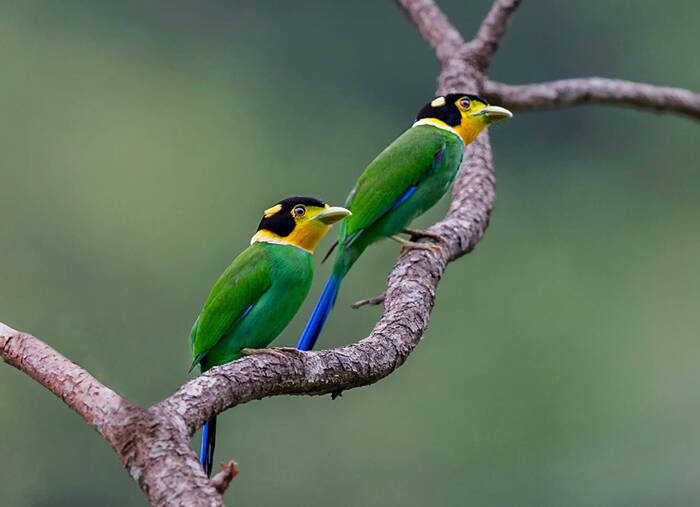Psarisomus dalhousiae
IUCN
LCBasic Information
Scientific classification
- name:Psarisomus dalhousiae
- Scientific Name:Psarisomus dalhousiae,Long-tailed Broadbill
- Outline:Songbird
- Family:Passeriformes B.family L.Broadbill
Vital signs
- length:20-28cm
- Weight:47-79g
- lifetime:No verification information
Feature
Not good at throat noise and jumping
Distribution and Habitat
Distributed in Bangladesh, Bhutan, Cambodia, China, India, Indonesia, Lao People's Democratic Republic, Malaysia, Myanmar, Nepal, Thailand, Vietnam.
In China, the nominate subspecies is a resident bird found in southeastern Tibet, western and southern Yunnan, southwestern Guangxi, and southwestern Guizhou. Protected areas: Dawei Mountain, Jinping Watershed, Gaoligong Mountain, and Tongbi Pass.
The long-tailed broadbill is a tropical forest bird, usually inhabiting evergreen broad-leaved forests at an altitude of 880-1500 meters. It is not common in subtropical primary forests and mature secondary mountain forests, usually found at an altitude of 700-1500 meters, but can be as high as 2000 meters in the Himalayas. It is commonly found in tropical evergreen broad-leaved forests below 2000 meters above sea level.
Appearance
The plumage color of male and female birds is similar, both are brighter, with brown or reddish-brown irises; yellow-green bill; olive-green tarsometa and toes. The mouth is broad and flat. The head and whisper are bright black, with a bright blue patch in the center of the top, slightly stained with purple or light yellowish white, shining with gem luster; there is a bright yellow spot on each side of the back pillow. From the baseline of the forehead to the eyes, the throat and sides of the neck are bright yellow. The bases of the two wings are bright diamond blue, forming significant wing mirrors, and the rest are dark blue and green, with white wing spots near the base. The upper body is bright grass green; the lower body is light green, more or less light blue. The surface of the tail feathers is bright blue. The plumage color of the female bird is similar to that of the male bird.
Iris - green and gray; mouth - green, upper tip blue, lower tip yellow; feet - green.
Size mea
Details
The foreign name of the long-tailed broadbill is Long-tailed Broadbill, and there are 5 subspecies.

Long-tailed broadbill is often seen in groups of more than ten or even twenty or thirty, foraging; they mainly feed on insects and fruits. They usually live quietly on bushes or small trees in the shade and wet places under the forest. They are not good at singing or jumping. They mainly feed on insects and other arthropods, and also eat small vertebrates and fruits. Food types include spiders, black ants, beetles, seeds, figs, drupes, beetles, stink bugs, bees, etc.
During the breeding season, the long-tailed broadbill nests in the tropical rainforest in the valley at an altitude of 650 meters, on the bushes and shrubs beside the stream. The nests are all woven from mountain grass, grass roots and vines. The nests are pear-shaped, tied to the branches, and hung on the water surface 1.2-1.8 meters above the water. Each nest is about 6-12 meters apart. The nest is 32 cm long, 13 cm wide at the bottom, and 6 cm in diameter. There are 4-5 eggs in the nest. The eggs are white in shell and have no spots.
In February 2022, the Management Bureau of Yunnan Puzhehei Provincial Nature Reserve discovered an unknown bird with green feathers, a long blue tail and a wide beak during the autumn and winter bird monitoring at the No. 3 bird monitoring sample line of Puzhehei Karst National Wetland Park. After comparison and confirmation, it was determined to be the long-tailed broadbill, a national second-level key protected animal.
Listed in the "Red List of Endangered Species of the World Conservation Union" (IUCN) 2016 ver 3.1-Least Concern (LC).
Listed in China's "National Key Protected Wildlife List" (February 5, 2021) Level 2.
Protect wildlife and eliminate game.
Maintaining ecological balance is everyone's responsibility!








